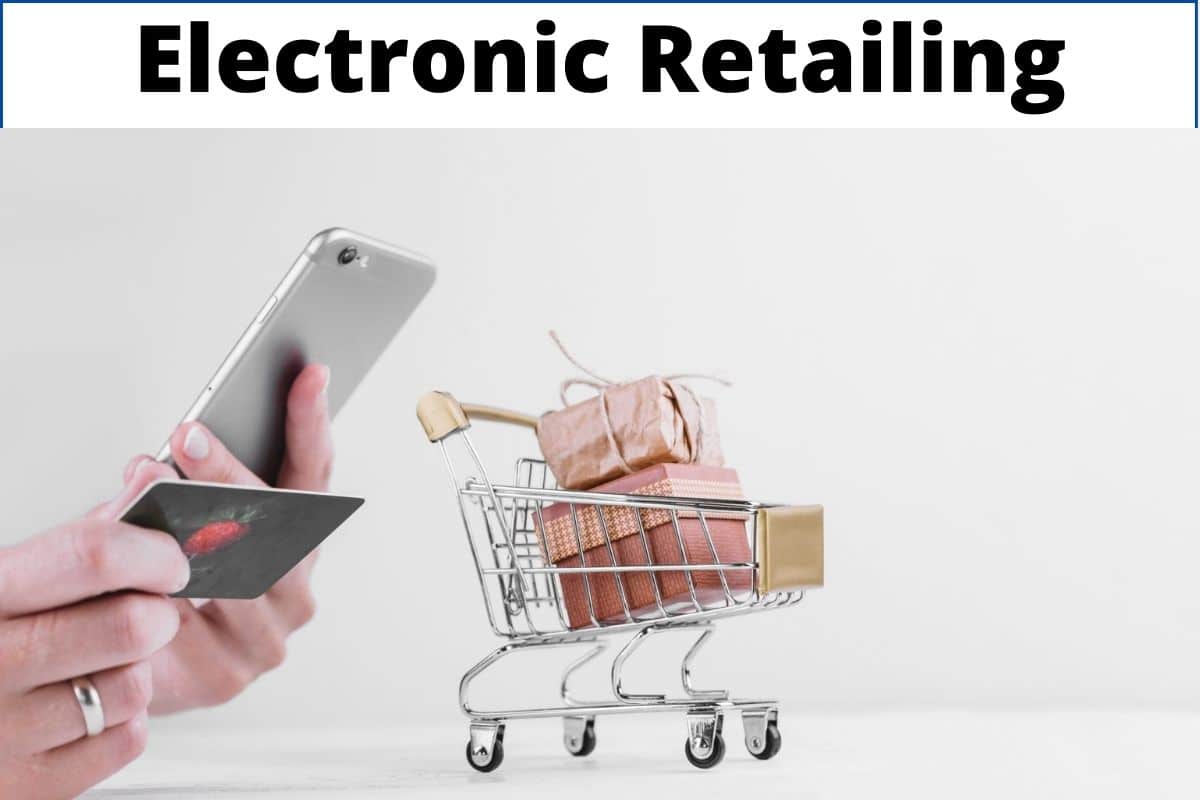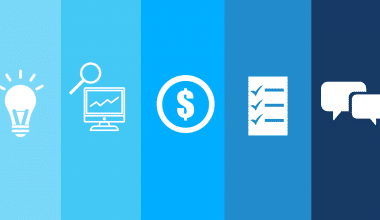Electronic retailing (e-Retailing) or online retailing is the sale of goods and services over the Internet. E-retailing can include business-to-business (B2B) and business-to-consumer (B2C) product and service sales. With e-tailing, companies must adapt their business models to capture Internet sales. This also includes the development of sales channels such as warehouses, Internet websites, and product dispatch centers.
How Electronic Retailing (E-Retailing) works
E-retailing spans a wide range of businesses and industries. However, there are similarities between most e-commerce businesses, including having a responsive website, an online marketing strategy, efficient product or service distribution, and analyzing customer data.
Successful e-retailing requires a strong brand. Websites should be attractive, easy to navigate, and regularly updated to meet the changing needs of consumers. Products and services must differentiate themselves from competitive offerings and create added value for consumers’ lives. Also, a company’s offerings must be competitively priced so that consumers don’t prefer one company over another based on cost.
Electronic retailers need strong distribution networks that are fast and efficient. Consumers cannot wait long for products or services to be delivered. Transparency in business practices is also important for consumers to trust and stay loyal to a company.
There are many ways that businesses can generate income online. The first source of income is, of course, selling your product to consumers or businesses. But both B2C and B2B companies could make money by selling their services through a subscription-based model like Netflix, which charges a monthly fee to access multimedia content.
Income can also be generated through online advertising. For example, Facebook generates revenue from the ads that companies display on their website that they want to sell to Facebook users.
What are the 5 C’s of e-Retailing?
The 5 C’s of e-retailing includes:
- Content
- Channel
- Customer
- Commerce
- Creative
Types of e-retailing
Business-to-consumer (B2C) e-commerce
Business-to-consumer retail is the most common type of e-commerce, and the one most Internet users are familiar with. This group of retailers includes companies that sell goods or manufactured products to consumers online through their websites. Products can be shipped and delivered from the company’s warehouse or the manufacturer. One of the most important things for a B2C retailer to do well is maintain good customer relationships.
Business-to-business (B2B) e-commerce
Business-to-business retail includes businesses that sell to other businesses. These retailers include consultants, software developers, freelancers, and wholesalers. Wholesalers sell their products in bulk from their manufacturing facilities to companies. These companies, in turn, sell these products to consumers. In other words, a B2B company, like a wholesaler, can sell products to a B2C company.
What are the Features of E-retailing?
In e-retail, a company or individual offers retail products and services via internet stores. An e-retail company can have an entirely digital presence, which means there is no physical store for customers to visit. However, an e-retail business can also be a physical store with an online presence.
What are the Stages of Retailing?
A theory of retail competitiveness contends that, like the goods they sell, retail establishments go through a recognizable cycle. Four main stages can be identified within this cycle: invention, fast development, maturity, and decline.
What is Retailing Strategy
The method you employ to create your goods or services and market them to clients is known as a retail strategy. This strategy consists of several components: location, store, goods/assortment, visual merchandising, personnel, service, mass media, communications, and price.
What are the 3 Types of Retail Distribution Strategies?
Manufacturers can choose one of three distribution strategies to describe how they want their products to be distributed throughout the market. Below are the distribution strategies:
- Intensive Distribution: The greatest number of outlets.
- Specialized Distribution: Fewer outlets
- Selective Distribution: The use of particular outlets in particular places.
E-tailer Examples
Amazon.com (AMZN)
Amazon is the largest online retailer, selling consumer products and subscriptions through its website. Amazon’s website reveals that the company had sales of more than $ 230 billion in 2018 and, at the same time, generated more than $ 10 billion in profit, or net income. Other electronic retailers that work exclusively online and compete with Amazon are Overstock.com and JD.com.
The Alibaba Group (BABA)
Alibaba is the biggest electronics store in China. It sells goods online in China and around the world. Alibaba has introduced a business model that not only includes B2C and B2B trade.
They connect Chinese exporters with companies worldwide looking to buy their products. The company’s Rural Taobao Program helps rural consumers and businesses in China to sell agricultural products to people in urban areas. Alibaba had nearly $ 40 billion in annual sales and a profit of just under $ 10 billion in 2018.
E-tailing advantages and disadvantages
The benefits of electronic retailing include:
- Easy Market Access – In many ways, market access has never been easier for entrepreneurs. Anyone can set up a simple online store and sell products in minutes in online marketplaces like eBay and Amazon. See the sale through online marketplaces.
- Reduced Overall Costs – Selling online eliminates the need for expensive retail stores and customer-facing employees so that you can invest in a better customer and marketing experience on your e-commerce website.
- Rapid Growth Potential- Selling on the Internet means traditional restrictions on retail growth: e. B. Finding and paying for larger products are not essential factors. You can respond and increase sales with a good digital marketing strategy and a plan for an order fulfillment system at scale. See Planning for e-commerce.
- Expand your market/export – A great advantage over local retailers is the ability to expand your market beyond local customers quickly. You may find that your products are in high demand in other countries. You can respond to this with targeted marketing, offering your website in a different language, or working with a foreign company. See Export basics.
- Customer Intelligence – The ability to target new customers using online marketing tools and website analytics tools to understand your customers’ needs better. Read more guides on how to improve your customers’ experience
Disadvantages of E-Retailing
Some negative aspects of electronic retailing are:
- Website Costs: Planning, designing, building, hosting, securing, and maintaining a professional eCommerce website is not cheap, especially if you expect large and growing sales volumes. Check out the common pitfalls of e-commerce.
- Infrastructure Costs: Even if you are not paying the cost of customer space, you need to consider the cost of physical space for order fulfillment, merchandise storage, returns processing, and staffing. See Fulfill orders online.
- Security and fraud: The growth of the online retail market has drawn the attention of sophisticated criminal elements. Your company’s reputation can be deadly if you don’t invest in the latest security systems to protect your website and transactional processes. See Ecommerce Errors: Security Vulnerabilities.
- Legal Issues: Dealing with e-commerce and the laws can be challenging. You must know and plan how to deal with the additional customer rights associated with online sales. Check the law and sell online.
- Advertising Expenses: While online marketing can efficiently attract the right customers for your products, it requires a generous budget. This is especially true when competing in a crowded industry or for popular keywords. See pay-per-click and paid search advertising.
- Customer Trust: Establishing a trusted brand can be difficult, especially without a physical company with a history and face-to-face interaction between customers and sales reps. You should consider the cost or the establishment of a good customer service system as part of your online offering.
What are the Most Popular Products in E-tailing?
- Phone Tripod.
- Portable Solar Panels
- Laser Hair Removal Machines.
- Portable Car Vacuum.
- Baby Swings.Matcha Tea.
- Eyebrow Razor.
- Seat Cushions.
E-tailing vs e-Commerce
E-tailing is the implementation of business processes on the Internet. Electronic commerce (electronic commerce or e-Commerce) is the purchase and sale of goods and services, or the transfer of funds or data through an electronic network, mainly the Internet. E-commerce generally creates a platform for sellers to offer their products or services to consumers.
Do you want to start online retailing? Check out 6 Easy Steps to Developing a Business Plan Outline for your business
RELATED: E Marketing: The Ultimate Guide
What Is Online Retailing Example?
The sale of goods and services over the internet is called “electronic retailing.” Business-to-business (B2B) and business-to-consumer (B2C) sales of goods and services can be made through e-commerce. Amazon.com (AMZN) is the biggest online store selling consumer goods and subscriptions.
Is Amazon an Online Retailer?
Amazon is the biggest online store in the world, and it is quickly expanding into other areas like brick-and-mortar stores, subscription services, and web services. Target, Walmart, Best Buy, and Costco are some of the stores that compete with Amazon.
Which Type of E-Commerce Is Amazon?
Consumer-to-customer eCommerce is one of the oldest types of eCommerce. It is the sale of goods or services between customers. This includes sales between two people, like those on eBay or Amazon.
Reference
- ELECTRONIC MONEY: How It Works, Advantages and, Disadvantages
- Electronic Commerce (e-commerce): Definition, Websites, Advantages, and Disadvantages
- ONLINE RETAIL: All You Need To Know
- RETAIL BUSINESS: Definition, Types & How to Start It
- RETAIL INSURANCE: Meaning & How to Get One for Your Business






